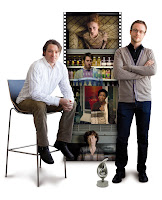
Last week, Associate Creative Director Sergio Flores attended the AdAge Digital Conference. Here are some of the bits, as he says, that raised his eyebrows, made him frown or just put a smile on his face. Heeeeeere's Sergio!
Let me begin by giving you a flavor of the conference with a few soundbites.
“Someone has to take the lead and orchestrate all the agencies”
“Brands are now content providers”
“Agencies need to understand how to create guided experiences”
“Agencies present problems to solve, rather than solutions to fund”
“You can’t play with a TV ad”
“Brands are about behavior, not just big ideas”
If you want more sound bites — check #aadigital on twitter.
And if you want to see great digital creative, ‘speed read’ to the end for some links.
On to the presenters I liked best.
James Farley, Group VP Global Marketing, Ford Motor Company.
For me, this might have been the most interesting presentation, and from a traditional agency perspective, the scariest.
James began by stating that the financial crisis has forced innovation and experimentation. And he’s grateful for that.
His view on the role of marketing? Shrinking the time of discovery of great products. He’s spending 1 out of 4 dollars on digital to do that.
The most impressive part of his presentation was the launch of the Ford Fiesta. The idea came from China, where the vehicle was launched purely on social media. (BTW, the Chinese offer a Brand Protection Package designed to erase negative online commentary. He passed.) But back to the USA, where they launched a car that is not even on sale here yet.
Ford brought over some of their European cars and gave them to Fiesta Agents—a bunch of creative young folk who proceeded to make music videos, songs, and short films about their Fiestas.
- 6 million views for a car that is not even available for sale yet.
- Ten thousands pre-launch vehicle reservations.
- And a customer feedback loop that is helping engineers come up with new ideas that are customer-relevant before they release the cars.
Check it out at http://www.fiestamovement2.com/
Vivian Schiller, President and CEO—NPR
The digital space is the perfect fit for NPR and their content. They have been happy to discover that there is such a thing as Citizen Journalism. Vivian shared an anecdote that followed the breaking of the Balloon Boy story—a group of physicists started a long thread about the science behind the event which turned out to be not only educational for the audience at large but also a great hit.
She was also giddy about their new app for the iPAd. She has every right to be. It’s pretty cool.
Duncan Watts, Principal Research Scientist, Yahoo!
Mr. Watts managed to make science engaging.
He talked about 1967’s The Small World Experiment, designed by Stanley Millgram to see how people in a large social group are linked together. And how relevant that human behavior is to today’s social media networks.
What I found most interesting though, was another experiment designed to ascertain what makes a musical hit (wouldn’t we all like to know). A web-based experiment—Music Lab—was set up at Columbia University to observe peer influence on musical choices. http://tinyurl.com/y57yofq
It turned out that peer influence (ratings, recommendations, likes, thumbs up, etc) can make a song rise to the top very quickly. However, when they introduced deception by positively rating random songs, people ignored the peer recommendations if the song was deemed a dud.
The insight? A good product can benefit from social media. But on the other hand, a bad product can die a quicker death.
He also mentioned that Kim Kardashian gets $10,000 a tweet. Time to get those buttocks implants.
Brad Jakeman, Chief Creative Officer, Activision Publishing
Call of Duty rocks.
The intro to this presentation was so loud it rattled my brain into submission. I was in awe of whatever Mr Jakeman said.
The launch of Call of Duty Modern Warfare 2 was the biggest entertainment launch of all time.It was a collaboration of Hollywood writers, game developers and even the Department of Defense. But here are some shocking and awesome figures.
- $550M in sales in the first week.
- It ‘fields’ the largest army in the world.
- 8 million people play worldwide.
The other interesting fact was that this launch was a departure from the mass media-to-digital model. They launched via a single tweet followed by the online release of one video asset which linked to a TV and Cinema spot. This video was embedded with easter eggs for people to voraciously find and talk about on social media networks, completing a full circle.
And finally… here’s some of the cool work!
BANNER CONCERTS—Actual bands playing in stages designed in the shape of the banner.
http://tinyurl.com/yymxeub
http://www.youtube.com/watch?v=f4rnk5fAY64
HIT THE GAS PEDAL—great banner for VW
http://tinyurl.com/b4hu4g
FURNITURE ASSEMBLY—Great demo banner
http://tinyurl.com/yevy7ux
REAL TIME CONTEXTUAL BANNERS—Wow
http://tinyurl.com/cs46ho
PSA BANNERS—amazing.
http://tinyurl.com/y9lyygg
NIKE SPORSTWEAR ON THE RUN— rich media from those just-do-it guys.
http://tinyurl.com/c6zn5m
CHALKBOT—Inspirational messages tweeted then painted BY A ROBOT on the Tour De France circuit.
http://www.deeplocal.com/portfolio/nike-chalkbot
Sergio Flores
Associate Creative Director
Read more...





